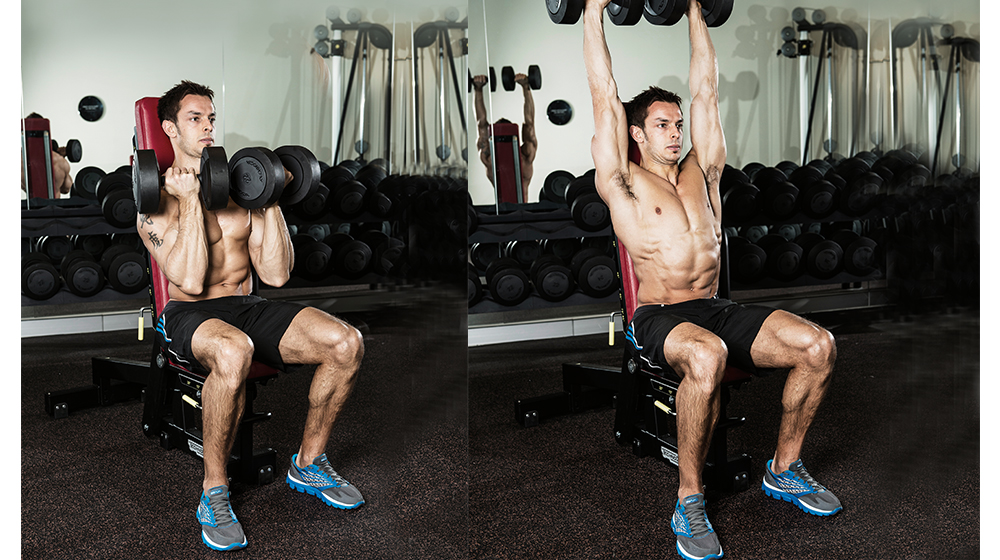How To Do The Arnold Press Exercise
Build boulder shoulders with Schwarzenegger’s patented lift

If you want to build the kind of broad, muscular shoulders that can win a handshake-off with Carl Weathers, best the Predator and control an entire class of kindergarten-age children, then you need to take a leaf out of Arnold Schwarzenegger’s training manual.
Arnie’s take on the dumbbell overhead press is undoubtedly one of the best shoulder exercises because it recruits all three sections of your deltoids—the round muscles at the tops of your upper arms—with the result that you build fuller, wider, more defined shoulders, and improve your posture to boot.
How to Do the Arnold Press
You can do the Arnold press standing, but USA Weightlifting Level 1-certified fitness coach Karl Bratland recommends grabbing a weight bench with the backrest set to 90° for support.
“Most people do it with their back supported with a bench, but if you don’t have that you can do it without. Just be careful you’re not using too much weight,” he says.
Remember, you won’t be able to go as heavy with the Arnold press as you would for a standard dumbbell shoulder press. So pick up a pair of moderate-weight dumbbells, sit down on the bench with your spine flush against the backrest. Place the weights on your knees and use your legs to kick them up to your shoulders.
“Hold the dumbbells right in front of your shoulders at collarbone height with your hands facing you, unlike a regular shoulder press,” says Bratland. “As you press the dumbbells up, rotate your hands to face away from you until you get to that [regular shoulder press] movement.”
From there, drive the weights upward until your elbows are fully extended. After you hit the top of the lift, reverse the movement to control the weights back to the starting position—and that’s a rep.
Get the Coach Newsletter
Sign up for workout ideas, training advice, reviews of the latest gear and more.
Arnold Press Form Tips
There are a few pitfalls to avoid when performing the Arnold press, so we asked Bratland to provide some top tips to help you press with the best of them.
First and foremost, he cautions against performing the exercise in two stages, moving your elbows to the sides and then performing a standard shoulder press. Instead, Bratland stresses that the Arnold press should be performed in one fluid motion. Begin to lift the dumbbells and start to rotate your wrists when the dumbbells are at head height.
Another common mistake Bratland sees is ego lifting. People reach for a heavy set of dumbbells and then curve their spine when pressing them overhead to bring their chest muscles into play and grind through reps.
“You don’t want to arch your back and compensate with your thoracic [mid] spine,” says Bratland. “Your shoulders should be doing the work. That’s why the back support sometimes helps people.”
Finally, he says, you need to make sure you hit full extension at your elbow at the top of each rep. Pushing your head through so your biceps are level with your ears can be a good form cue to help with this.
Arnold Press Benefits
You don’t have to go too heavy with the weight to achieve excellent results with the Arnold press (a bonus if the CIA has had you pushing too many pencils at your desk lately). The exercise keeps your muscles under tension longer and puts them through a greater range of motion than standard overhead presses do, meaning that despite the lighter weight you’ll still be stimulating plenty of new muscle growth.
The Arnold press also hits often neglected muscles and will help you improve your performance in other lifts, too. The anterior (front) deltoid tends to get plenty of work from press-ups and bench presses, but the medial (lateral) and posterior (rear) often get neglected. However, the Arnold press works all these evenly along with the stabilizer muscles, helping draw back the shoulders for a straight posture and assisting with big pulling moves such as deadlifts, pull-ups and rows.
Which muscles does the Arnold Press work?
The Arnold press is a shoulder-focused exercise, but that’s not the extent of this move's muscle-building potential.
“It’s going to hit your whole shoulder—your delts,” Bratland explains. “So your anterior at the front, posterior at the back and the medial delts in the middle. Then your triceps will be worked too, and it will also hit your upper back and traps.
“Some of the stabilizing muscles of the rotator cuff will be called into action as well, just because you’re going through that rotation. It’ll work your chest a little bit too.”
Arnold Press Vs Shoulder Press
The Arnold press and the shoulder press are similar. They both use dumbbells, both target the delts, and both recruit muscles like the triceps and rotator cuffs as supporting characters.
So what are the main differences between the two press techniques, and why should you pick one over the other?
The most obvious variation is the form. The Arnold press adds another element to the move by challenging you to rotate your wrists and bring the dumbbells lower (in front of the shoulders) at the bottom of each rep.
“The Arnold press will allow you to lift less weight because of the rotational component,” Bratland says. “With the shoulder press you’re going to move more weight and build more strength.”
Surely that’s settled then? The shoulder press is superior. Well, not quite. There’s a reason why Arnie put his name to this muscle-building move, and that reason is hypertrophy.
“If your main goal is purely muscle development or hypertrophy, the Arnold press would probably be better because the rotation is going to increase your time under tension,” Bratland says. “It hits the whole shoulder more because you have this rotational movement, and you get more of a range of motion.
“The rotational component will engage your shoulders and back in a different manner because you have to stabilize through that rotation. So it’s definitely going to hit the delts and the stabilizing muscles in the back.”
These impressive pros do come with a caveat though. If you lack the necessary strength, stability and mobility in your shoulders, the Arnold press can increase your risk of injury.
“If you don’t have the mobility in the shoulders or you have shoulder issues, I wouldn’t do the Arnold press,” Bratland says. “If you don’t have enough strength and stability [in the joint] you need to address that until you can do it pain-free.”
Workouts
Now you understand how to perform the Arnold press correctly, you’re no doubt itching to put it into practice. We can help with that, because naturally the Arnold press has featured in a range of workouts.
- The seated Arnold press makes an appearance in our best shoulder workout routine, supersetted with the seated lateral raise.
- The Arnold press rounds out a challenging tri-set in this dumbbell shoulder workout.
- If you’re looking for a full-body training plan, try this series of dumbbell workouts—which includes the Arnold press in the final of the four weekly workouts.
- Round off any workout with this four-move finisher, a full-body effort which culminates with the Arnold press.
- If you have a pair of dumbbells and a kettlebell, give this 20-minute home workout a go which combines the Arnold press with the biceps curl.
- To finish off, and to finish you off, give this dumbbell complex a whirl. The Arnold press caps off the combination of moves.
About Our Expert
Karl Bratland is a functional fitness and nutritional coach with an online fitness coaching business offering custom fitness and nutrition plans. He has a master’s degree in Exercise Science and several fitness certifications including a USA Weightlifting L1 and CrossFit Trainer.

Sam Rider is an experienced freelance journalist, specialising in health, fitness and wellness. For over a decade he's reported on Olympic Games, CrossFit Games and World Cups, and quizzed luminaries of elite sport, nutrition and strength and conditioning. Sam is also a REPS level 3 qualified personal trainer, online coach and founder of Your Daily Fix. Sam is also Coach’s designated reviewer of massage guns and fitness mirrors.
- Harry BullmoreStaff writer
- Nick Harris-FrySenior writer









